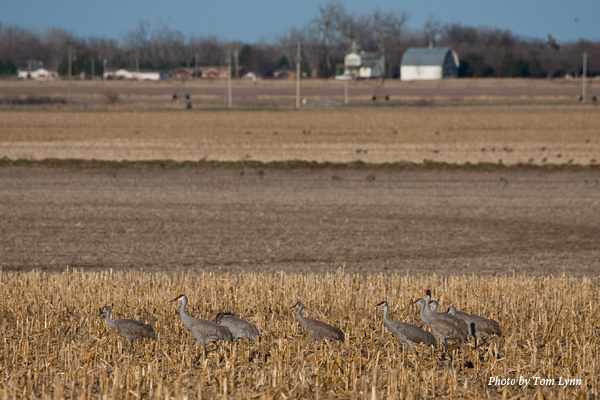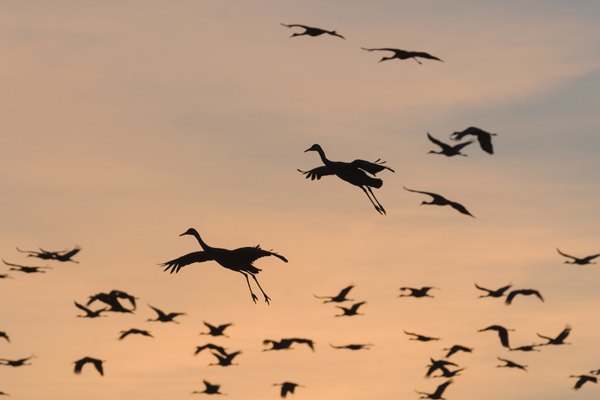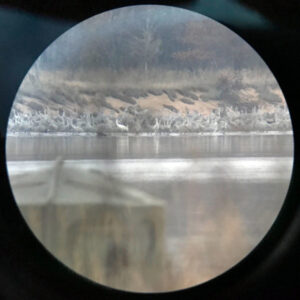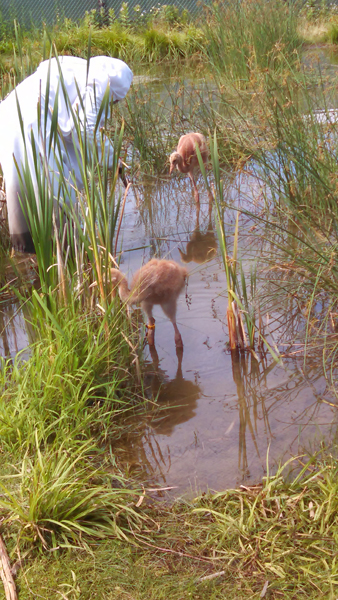Rare Sighting of Endangered Whooping Cranes Inspires Awe and Gratitude
The International Crane Foundation and the Aldo Leopold Foundation are both rooted in a love and respect for the land. Our headquarters are also neighbors, sharing the same landscape in southern Wisconsin. Over the last several years a growing number of Sandhill Cranes has started staging near the historic Aldo Leopold Shack during the fall migration. Where there are cranes, “craniacs” will follow, and it was a natural progression to organize a gathering of our two organizations to view the fall Crane Congregations.
On a clear fall afternoon we loaded into our vehicles and drove the fifteen minutes between our organizations, pausing as we drove to point out groups of foraging Sandhill Cranes on Shady Lane Road. Many of the cranes were visitors from further north stopping to rest and refuel on migration, skittish and wary of the passing cars.

We were on a pilgrimage of sorts, an opportunity to view our beloved cranes as they gathered during migration on the Wisconsin River, so close to both of our headquarters. Sandhill Cranes nearly disappeared from the sand barrens of southern Wisconsin. But today we can watch them as they gather in the thousands. Yes, thousands! A gathering that Aldo Leopold thought no one would ever see again, and one that our cofounders could only dream of when they met in the 1970s at Cornell University.
As we approached the viewing blind we heard the familiar calls. The cranes were arriving! After feeding for the day in the surrounding harvested fields, the cranes gathered together on the sandbars to roost for the night. As dusk approached the numbers of cranes grew, flying in from all directions, circling, and then finding just the right place to land. Among the adults’ calls, we heard the distinctive “cheep” calls of chicks, following their parents on their first migration.
The blind is divided into two parts – an interior viewing area with comfortable stools and windows, and an exterior with a wooden fence that hides curious birders from the cranes. Our group was large enough to be both inside and outside. Our spotting scopes and binoculars peered through the windows and fence, watching as ribbons of birds parachuted down for the evening.

We estimate that we saw at least 4,000 Sandhill Cranes that evening. As we looked closely, we saw something else. In total, standing amongst the Sandhills were three, big, white birds – Whooping Cranes! Our staff knew there were Whooping Cranes in the area. But to see them at the roost was thrilling. We called out the color combinations on the cranes’ leg bands, hard to see in the fading light, and quickly paged through our binder to find their IDs.

The first two Whooping Cranes were 65-15, or “Leola,” and her traveling companion 7-07. Both birds were far away and difficult to see until we turned to our left, and right in front of us was another Whooping Crane! Perhaps newly arrived that day was 68-15, also known as “Quill.” Both Leola and Quill were raised at our headquarters in 2015 and were released at Horicon National Wildlife Refuge in eastern Wisconsin their first fall. The cherry on the top? Our Chick Rearing Supervisor was with us at the blind. What a special joy to see two of the cranes that she and her team had devoted countless hours to preparing for release!

We left the blind that evening with a feeling of gratitude for the people that made this experience possible – our founders Aldo Leopold, George Archibald and Ron Sauey, the conservationists, hunters and farmers who care for this land, our supporters who make our work possible, and the strong partnership between our two organizations.
Cranes once nearly disappeared from Wisconsin. This evening, we saw firsthand how their numbers now are in the thousands. We also saw three Endangered Whooping Cranes, the rarest crane in the world. This species is making a slow, but fragile, recovery. We wonder what the next generation will see on the sand barrens of southern Wisconsin. We hope they will also be grateful for those that came before them.
 Story submitted by Sara Gavney Moore, Digital Communications Specialist. Click here to learn more about our work in North America.
Story submitted by Sara Gavney Moore, Digital Communications Specialist. Click here to learn more about our work in North America.
